I have a class question that I cannot seem to understand the logic for.
Modify the program below to print a histogram in which the total number of times the dice rolls equals each possible value is displayed by printing a character like * that number of times, as shown below.
Histogram showing total number of dice rolls for each possible value.
Dice roll histogram:
2: ******
3: ****
4: ***
5: ********
6: *******************
7: *************
8: *************
9: **************
10: ***********
11: *****
12: ****
I do not understand what in the world this histogram is displaying. Its driving me insane and I cannot move forward with my logic if I do not understand what I am doing. I know this question has been asked before but it looks like they all have a specific number of dice roles they are going off of. I am not given a number and this is what is throwing me off. I know this is really a stupid question. But can anyone possibly explain to me what they mean by "Histogram showing total number of dice rolls for each possible value" what is defining this possible value? I am at a total loss... Any help is appreciated. Here is the code I have written so far.
import java.util.Scanner;
import java.util.Random;
public class DiceStats {
public static void main(String[] args) {
Scanner scnr = new Scanner(System.in);
Random randGen = new Random();
int i = 0; // Loop counter iterates numRolls times
int numRolls = 0; // User defined number of rolls
int numOnes = 0; // Tracks number of 1's found
int numTwos = 0; // Tracks number of 2's found
int numThrees = 0; // Tracks number of 3's found
int numFours = 0; // Tracks number of 4's found
int numFives = 0; // Tracks number of 5's found
int numSixes = 0; // Tracks number of 6's found
int numSevens = 0; // Tracks number of 7's found
int numEights = 0; // Tracks number of 8's found
int numNines = 0; // Tracks number of 9's found
int numTens = 0; // Tracks number of 10's found
int numElevens = 0; // Tracks number of 11's found
int numTwelves = 0; // Tracks number of 12's found
int die1 = 0; // Dice values
int die2 = 0; // Dice values
int rollTotal = 0; // Sum of dice values
System.out.println("Enter number of rolls: ");
numRolls = scnr.nextInt();
if (numRolls >= 1) {
// Roll dice numRoll times
for (i = 0; i < numRolls; ++i) {
die1 = randGen.nextInt(6) + 1;
die2 = randGen.nextInt(6) + 1;
rollTotal = die1 + die2;
// Count number of sixes and sevens
if (rollTotal == 1) {
numOnes = numOnes + 1;
}
if (rollTotal == 2) {
numTwos = numTwos + 1;
}
if (rollTotal == 3) {
numThrees = numThrees + 1;
}
if (rollTotal == 4) {
numFours = numFours + 1;
}
if (rollTotal == 5) {
numFives = numFives + 1;
}
if (rollTotal == 6) {
numSixes = numSixes + 1;
}
if (rollTotal == 7) {
numSevens = numSevens + 1;
}
if (rollTotal == 8) {
numEights = numEights + 1;
}
if (rollTotal == 9) {
numNines = numNines + 1;
}
if (rollTotal == 10) {
numTens = numTens + 1;
}
if (rollTotal == 11) {
numElevens = numElevens + 1;
}
else if (rollTotal == 12) {
numTwelves = numTwelves + 1;
}
System.out.println("Roll " + (i+1) + " is " + rollTotal + " (" + die1 +
"+" + die2 + ")");
}
// Prints a histogram of the number of dice rolls
System.out.println("\nDice roll histogram:");
System.out.println("1's: " + numOnes);
System.out.println("2's: " + numTwos);
System.out.println("3's: " + numThrees);
System.out.println("4's: " + numFours);
System.out.println("5's: " + numFives);
System.out.println("6's: " + numSixes);
System.out.println("7's: " + numSevens);
System.out.println("8's: " + numEights);
System.out.println("9's: " + numNines);
System.out.println("10's: " + numTens);
System.out.println("11's: " + numElevens);
System.out.println("12's: " + numTwelves);
}
else {
System.out.println("Invalid rolls. Try again.");
}
return;
}
}
You can see where I entered the entry for histograms. I basically thought that I needed to edit my value given from the integers such as "numOnes" to asterisk but now I'm not certain... any help is appreciated!
EDITED CODE -
System.out.println("\nDice roll histogram:");
System.out.print("2's: ");
for(i = 0; i < numTwos; i++){
System.out.print("*");
}
System.out.println("");
System.out.print("3's: ");
for (i = 0; i < numThrees; i++);{
System.out.print("*");
}
System.out.println("");
System.out.print("4's: " );
for (i = 0; i < numFours; i++);{
System.out.print("*");
}
System.out.println("");
System.out.print("5's: ");
for (i = 0; i < numFives; i++);{
System.out.print("*");
}
System.out.println("");
System.out.print("6's: ");
for (i = 0; i < numSixes; i++);{
System.out.print("*");
}
System.out.println("");
System.out.print("7's: ");
for (i = 0; i < numSevens; i++);{
System.out.print("*");
}
System.out.println("");
System.out.print("8's: ");
for (i = 0; i < numEights; i++);{
System.out.print("*");
}
System.out.println("");
System.out.print("9's: ");
for (i = 0; i < numNines; i++);{
System.out.print("*");
}
System.out.println("");
System.out.print("10's: ");
for (i = 0; i < numTens; i++);{
System.out.print("*");
}
System.out.println("");
System.out.print("11's: ");
for (i = 0; i < numElevens; i++);{
System.out.print("*");
}
System.out.println("");
System.out.print("12's: ");
for (i = 0; i < numTwelves; i++);{
System.out.print("*");
}
System.out.println("");
}
OUTPUTS -
Enter number of rolls:
5
Roll 1 is 8 (2+6)
Roll 2 is 9 (6+3)
Roll 3 is 9 (5+4)
Roll 4 is 6 (4+2)
Roll 5 is 9 (6+3)
Dice roll histogram:
2's:
3's: *
4's: *
5's: *
6's: *
7's: *
8's: *
9's: *
10's: *
11's: *
12's: *
I can enter a larger number of rolls and I will get an asterisk for the 2's and it will increase like I need but it will not increase the rest of the numbers and they all only get one asterisk. What is keeping my code from properly increasing the amount of *'s? Iv been fighting with this for hours :/



